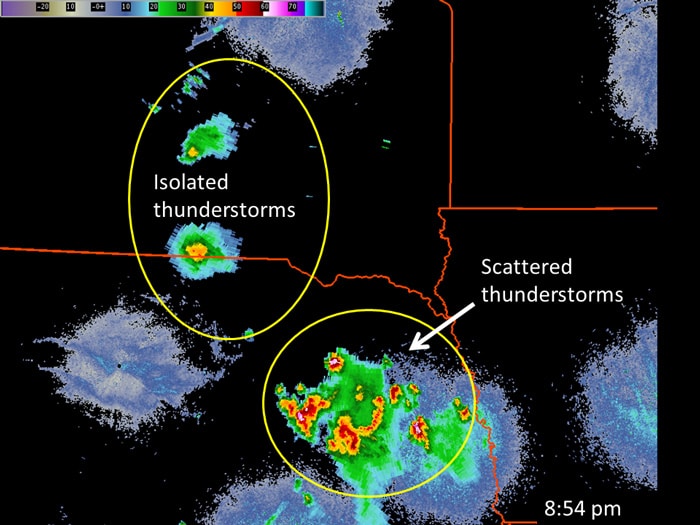
So, your local TV meteorologist has just announced that thunderstorms are in the forecast. But should you cancel your plans? Maybe not. Depending on how the forecast is worded, you might still be able to enjoy your favorite outdoor activity sometime during the day. In this blog post, we’re going to explain the difference between isolated and scattered thunderstorms.
When these words appear in your forecast, it is meant to describe the expected extent of thunderstorm activity. Unlike organized lines of storms, isolated and scattered storms affect a far smaller area so not everyone will experience them.
What Does Isolated Thunderstorms Mean?
When this appears in, it means less than about 20 percent or so of the forecast area is expected to experience storm activity at any one time. Isolated storms are the most difficult to forecast and plan for. It’s entirely possible that one area is entirely sunny while just 10 or 20 miles in the distance a thunderstorm rages.
In some cases, just one or two storms develop, which further localizes the thunderstorm risk. This is especially dangerous, and we’ll explain later on why.
In most cases, there’s no need to cancel any outdoor activities when isolated storms are forecasted. There’s a higher probability of you not getting caught in a storm, but keep an eye on the sky just in case. If you see lightning in the distance, take cover and wait it out. There’s a good chance that you’ll be able to resume your activities shortly, and better weather will return.

Radar image with an example of isolated vs. scattered thunderstorms.
(Image Credit: National Weather Service)
What Does Scattered Thunderstorms Mean?
Scattered thunderstorms are more numerous in nature and cover a larger area. Here, your chances of seeing thunderstorm activity are significantly higher. At any given time, between 30-50% of the forecast area is covered by storms. You’ll likely need to adjust your outdoor plans, and it will be a good idea to postpone them until after the threat of storms pass.
Since scattered storms cover a greater area, it’s possible for one particular location to be hit by more than one storm (with isolated storms the threat of this happening is considerably less). Areas that are forecasted with scattered thunderstorms will often encounter multiple rounds of storms throughout the day. On these days you will most likely experience a downpour for several minutes, and then the sun may come out, only to have another thunderstorm roll in 30 minutes later. There is also increased lightning activity, so it’s a good idea to remain indoors as long as you see lightning in the distance. Lightning often strikes many miles from the core of the storm itself.
While it’s still difficult to pinpoint exact spots to be affected, days with scattered thunderstorms forecasted typically are much cloudier, and even if you don’t exactly get a thunderstorm, with the increased amount of instability weaker showers and sprinkles may pop up around these storms too.
Final Thoughts
One thing that you must keep in mind is that the terms “isolated” and “scattered” do not describe anything about the storm’s strength. Severe storms don’t always occur in an organized fashion. Instead, isolated vs. scattered thunderstorms refer to the coverage of the storms over the forecast area. Severe storms don’t always occur in an organized manner.
In fact, isolated thunderstorms can be especially intense and thus more dangerous because conditions can deteriorate so rapidly. These storms can quickly become quite intense and in rare cases even tornadic.
Luckily, there are often signs in atmospheric conditions pointing to stronger storms, even if only isolated and scattered, so your local meteorologist often warns of this ahead of time. Regardless, you should always follow the safety slogan “when thunder roars, go indoors” and take cover as soon as possible in an enclosed shelter! For more information regarding lightning safety, see our post on lightning safety tips if you’re caught outside in a thunderstorm.
The above percentages also shouldn’t be confused with the actual “Probability of Precipitation,” that chance of rain percentage you see in forecasts. The rain percentage meaning is easy to misinterpret. It’s actually a (somewhat confusing) mix of the forecaster’s certainty that precipitation will form and the percentage of the area where it might occur.
Have any questions? Leave a comment below, and we will be glad to answer them.





excellent description on difference in isolated and scattered. Climatic change involving global warming I guess is another topic of confusion..I been stating that general warm up of planet atmosphere is increasing energy that shows up in extremes of wind and temp range differences . I been hearing confusion on local variations being called into question both for and against proof of Global warming
Thank you. Exactly the information I needed. Good explanation.